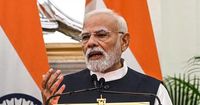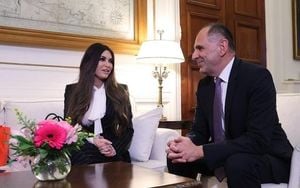On the eve of the 2025 Navaratri festival, India’s economic and political landscape is buzzing with a renewed call for self-reliance. Prime Minister Narendra Modi has reignited the Swadeshi movement, urging citizens to turn away from foreign-made products and embrace goods and services made on home soil. This push for "Make in India" comes at a time when India faces escalating trade tensions with the United States, especially after the Trump administration slapped a hefty 50 percent tariff on Indian imports.
Addressing the nation on September 21, 2025, Modi left little room for ambiguity. “Today, knowingly or unknowingly, many foreign products have become a part of our everyday lives,” he reflected, as reported by Times Now. “We should buy products that are Made in India, in which the hard work of our country’s youth is invested.” His message was clear: every Indian household and shop should become a “symbol of Swadeshi.”
This call to action wasn’t just rhetorical. It arrived on the cusp of major reforms to India’s Goods and Services Tax (GST), which took effect on September 22. The changes, described by Modi as “Next Generation GST reforms,” lowered tax rates on a broad range of essentials—packaged foods, medicines, insurance, consumer durables, farm equipment, and even services like gyms and hotels. The new structure features two main slabs, 5 percent and 18 percent, while luxury and so-called "sin" goods are taxed at 40 percent. According to The Times of India, these reforms are designed to make daily necessities more affordable and simplify the complex GST code, easing the compliance burden for businesses and consumers alike.
“With the reduction in GST, it will be easier for the citizens of the country to fulfill their dreams,” Modi enthused in his national address. In an open letter published on September 22, he added, “These reforms will boost savings and directly benefit every section of society, be it farmers, women, youth, poor, middle class, traders, or MSMEs. They will encourage greater growth and investments and accelerate the progress of every state and region.”
The timing of these reforms—just ahead of the holiday shopping season—was no accident. Modi called the changes an “added reason to rejoice” during Navaratri, hoping to spur consumption at a moment when household spending is under pressure from the new U.S. tariffs. FMCG companies have already begun to respond, reducing prices on juices, chocolates, dairy, and personal care items, according to The Times of India. Anecdotal accounts from car and motorcycle dealerships, cited by the BBC, suggest customers are increasingly inquiring about unsold inventory, hoping to capitalize on the lower tax rates.
Yet, not everyone is convinced. On social media, opposition leaders have seized on what they see as contradictions in the government’s message. Arvind Kejriwal, leader of the Aam Aadmi Party (AAP), questioned Modi’s commitment to Swadeshi, asking pointedly whether the Prime Minister would give up his foreign airplane, watches, glasses, phones, and cars. AAP MP Sanjay Singh joined in, highlighting India’s ongoing imports from the U.S. and China and calling Modi’s Swadeshi push “hypocritical.” The debate has spilled over into the business community as well, with some shopkeepers and traders expressing confusion about the new GST reforms—especially since tax rates on certain higher-priced garments have actually increased.
In the midst of this swirl, Union Minister for IT, Railways, and Information and Broadcasting Ashwini Vaishnaw made headlines by announcing his switch from foreign software to the indigenous Zoho platform for documents, spreadsheets, and presentations. “I am moving to Zoho—our own Swadeshi platform for documents, spreadsheets and presentations. I urge all to join PM Shri Narendra Modi ji’s call for Swadeshi by adopting indigenous products & services,” Vaishnaw declared on X (formerly Twitter), as reported by Times Now. Zoho’s founder, Sridhar Vembu, responded with gratitude: “This is a huge morale boost for our engineers who have worked hard for over two decades to build our product suite. We will make you proud and make our nation proud.”
Modi’s Swadeshi campaign isn’t just about consumer choices; it’s a response to the pressure cooker of international trade. The Trump administration’s tariffs—25 percent initially, followed by an additional 25 percent in response to India’s continued purchase of Russian oil—have put India in a tight spot. These trade measures are widely seen as punishment for India’s foreign policy choices, and they threaten to dampen already fragile household consumption.
Despite the tough rhetoric, India’s government has opted for a measured response. Defence Minister Rajnath Singh explained on September 22 that India would not react to the U.S. tariffs immediately, signaling a preference for negotiation over escalation. Trade talks are ongoing: Indian Foreign Minister Subrahmanyam Jaishankar met with U.S. Secretary of State Marco Rubio on the sidelines of the United Nations General Assembly in New York, while Trade Minister Piyush Goyal traveled to Washington, D.C. for further discussions. Goyal has remained optimistic but firm, insisting that India will not compromise on protection for its agricultural sector—a key sticking point for U.S. negotiators.
Meanwhile, the Swadeshi message is being amplified across government and media. Modi’s X social media header now features the “GST Bachat Utsav” banner and the slogan “har ghar swadeshi, ghar ghar swadeshi”—every home, Swadeshi; Swadeshi in every home. In his open letter, Modi reiterated, “This festive season, let us also resolve to support products that are Made in India. This means buying Swadeshi products that have the sweat and toil of an Indian involved in their making, irrespective of the brand or the company that makes them.” He also appealed to shopkeepers and traders to sell only products made in India: “Let us proudly say—what we buy is Swadeshi. Let us proudly say—what we sell is Swadeshi.”
The GST reforms, Swadeshi campaign, and the government’s diplomatic balancing act are all unfolding against a backdrop of ongoing domestic and international challenges. The blast in Pakistan’s Tirah Valley, which killed at least 30 people, has heightened regional tensions, while recent attacks by the Tehrik-i-Taliban Pakistan (TTP) have underscored the volatility of India’s neighborhood. Human rights groups and opposition parties in Pakistan have called for impartial investigations and accountability for civilian deaths, adding another layer of complexity to India’s foreign policy calculus.
Back home, the spirit of Swadeshi is finding unlikely champions beyond politics. In the world of cricket, Virender Sehwag lauded Abhishek Sharma’s fearless 74-run performance in India’s victory over Pakistan, noting Sharma’s remarkable consistency and high strike rate—perhaps a metaphor for the kind of homegrown excellence Modi hopes to inspire across all sectors.
As Navaratri festivities begin, the country stands at a crossroads. Can the Swadeshi movement, bolstered by tax reforms and a sense of national pride, truly offset the headwinds of global trade disputes? Only time will tell, but for now, the government’s message is loud and clear: India’s future, it seems, is Made in India.




